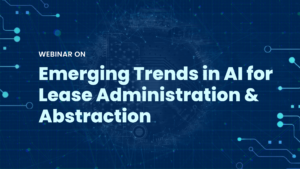Lease administration stands as a pivotal function within businesses, crucial for managing a diverse lease portfolio effectively. Yet, in-house lease teams often grapple with numerous challenges, a key one being resource shortage that hinders their ability to navigate the complexities of lease administration efficiently. Our blog this week discusses the transformative potential of outsourcing lease administration, exploring how it can empower in-house lease teams to focus on strategic initiatives and core business activities while enhancing overall lease management performance.
Understanding Lease Administration
Lease administration encompasses a spectrum of responsibilities vital for overseeing lease agreements effectively. These include lease abstraction, lease data management, compliance tracking, and financial reporting. The multifaceted nature of lease administration tasks demands meticulous attention to detail and a deep understanding of lease terms, regulations, and accounting principles. Ensuring accurate and timely lease administration is essential for optimizing lease performance, mitigating risks, and maintaining regulatory compliance.
Challenges Faced by In-House Lease Teams
In-house lease teams encounter various challenges in managing lease portfolios efficiently. Resource constraints, including limited staffing and budgetary allocations, often pose significant hurdles for in-house teams. Additionally, scalability issues arise when in-house teams are tasked with managing a growing number of leases without adequate support or infrastructure.
The Value of Outsourcing Lease Administration
Outsourcing lease administration to specialized service providers offers several compelling benefits for in-house lease teams. One primary advantage is cost savings, as outsourcing eliminates the need for significant upfront investments in technology, infrastructure, and personnel. By leveraging the expertise and economies of scale of outsourcing providers, in-house teams can access specialized skills and resources tailored to their specific lease management needs. Furthermore, outsourcing enables scalability, allowing businesses to adapt to fluctuations in lease volumes and complexity without incurring additional overhead costs.
Key Considerations for Outsourcing Lease Administration
When considering outsourcing lease administration, in-house lease teams must weigh several key factors to ensure successful partnerships. Firstly, selecting a reputable outsourcing partner with industry experience and proven track record is paramount. The outsourcing provider should demonstrate expertise in lease administration processes, regulatory compliance, and technology integration. Additionally, alignment of service offerings with organizational objectives and values is essential for fostering a collaborative and productive relationship. Clear communication channels and robust service level agreements (SLAs) are instrumental in establishing mutual expectations and accountability between in-house teams and outsourcing partners.
Real-Life Example and a Case Study
In a real-life example, one of America’s leading communication retailers partnered with RE BackOffice, a trusted lease administration service provider, to tackle the challenge of managing their lease portfolio efficiently. With dedicated CAM audit services, over $100,000 in overpayments were identified in the first year alone, helping the retailer cut lease administration costs by more than 60%. By providing timely reconciliations and accurate discrepancy communication, the team not only saved the client considerable costs but also improved the overall quality of their lease portfolio management processes. This ongoing partnership ensures the retailer continues to see significant cost savings every year, enjoying a healthy return on investment.
Best Practices for Successful Outsourcing
To maximize the benefits of outsourcing lease administration, in-house teams should adhere to best practices and strategic guidelines. Thorough due diligence in selecting outsourcing partners is essential, involving comprehensive evaluations of capabilities, references, and service offerings. Clearly defining objectives, expectations, and performance metrics upfront facilitates alignment and accountability throughout the outsourcing engagement. Additionally, fostering open communication and collaboration between in-house teams and outsourcing partners fosters trust, transparency, and continuous improvement. Regular monitoring, evaluation, and optimization of outsourcing arrangements ensure ongoing alignment with organizational goals and evolving lease management needs. Here’s a quick overview of some of the best practices that you can adopt when outsourcing your lease administration function to a trusted lease administration service provider-
- Thorough Due Diligence: Conduct comprehensive evaluations of potential outsourcing partners’ capabilities, references, and track records to ensure alignment with organizational goals.
- Clear Objective Definition: Clearly define objectives, expectations, and performance metrics upfront to facilitate alignment and accountability throughout the outsourcing engagement.
- Effective Communication: Foster open communication channels and frequent updates between in-house teams and outsourcing partners to promote transparency, collaboration, and problem-solving.
- Robust SLAs (Service Level Agreements): Establish clear service level agreements outlining deliverables, timelines, and quality standards to ensure mutual understanding and accountability.
- Collaborative Partnership: Cultivate a collaborative partnership mindset, treating outsourcing providers as extensions of the in-house team, rather than external vendors.
- Continuous Monitoring and Evaluation: Regularly monitor and evaluate outsourcing performance against established metrics and objectives, providing feedback and course corrections as needed.
- Flexibility and Adaptability: Maintain flexibility and adaptability in outsourcing arrangements to accommodate changing business needs, market conditions, and technological advancements.
- Risk Mitigation Strategies: Develop risk mitigation strategies to address potential disruptions, conflicts, and security concerns associated with outsourcing lease administration.
- Training and Knowledge Transfer: Provide training and knowledge transfer sessions to outsourcing partners to ensure alignment with organizational processes, policies, and culture.
- Continuous Improvement: Foster a culture of continuous improvement by seeking feedback, implementing lessons learned, and exploring opportunities for innovation and optimization.
Addressing common concerns and misconceptions
Despite the compelling benefits of outsourcing lease administration, organizations may harbor concerns and misconceptions about relinquishing control and exposing sensitive data to third-party providers. However, outsourcing partners adhere to strict confidentiality and security protocols to safeguard client information and mitigate risks. Moreover, outsourcing enables in-house teams to retain oversight and governance over lease management processes while leveraging external expertise and resources. By addressing common concerns and misconceptions transparently, organizations can build confidence and trust in outsourcing as a strategic approach to lease administration.
Future trends and opportunities in outsourced lease administration
Looking ahead, the future of outsourcing lease administration is characterized by technological advancements, evolving service delivery models, and emerging opportunities for innovation. AI-driven automation, predictive analytics, and blockchain technology hold promise for transforming lease administration processes, enhancing efficiency, and unlocking new insights into lease performance and trends. As organizations embrace digital transformation and harness the power of outsourcing, they stand poised to capitalize on future opportunities for optimizing lease management and driving business value.
In conclusion, outsourcing lease administration offers a compelling solution for empowering in-house lease teams to navigate the complexities of lease management effectively. By leveraging the expertise, resources, and scalability of outsourcing partners, organizations can streamline lease administration processes, enhance accuracy, and focus on strategic initiatives that drive business growth and competitiveness. While challenges and concerns may exist, proactive planning, strategic partnerships, and adherence to best practices can position organizations for success in outsourcing lease administration and achieving their lease management objectives.







